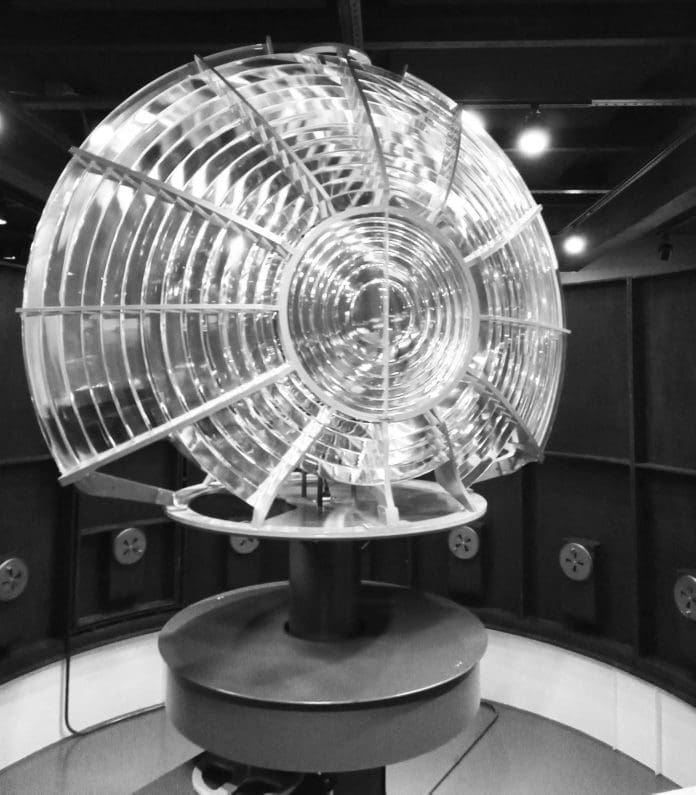The new exhibit at Split Rock Lighthouse features a working replica of the Fresnel lens. (Photo credit: Haley Searls)
Split Rock Lighthouse is proud to announce the completion of their most extensive programmatic update in a generation. North Shore Community Night, held on May 26th, will be the public’s first opportunity to view this new exhibit, featuring “previously untold stories about how the area’s people have tried to control Lake Superior and their interactions with the water.”
If you go to view the new exhibit, what can you expect to see?
Upon entering the room, your eyes will immediately be drawn to the centerpiece of the exhibit: a working replica of the Third Order
Bivalve Fresnel Lens that sits atop Split Rock Lighthouse. Crafted by Dan Spinella of Artworks Florida, the lens includes 252 prisms and weighs in at 650 pounds.
Split Rock’s original lens was crafted in Paris and arrived at Split Rock in 1910. The original lens, a marvel of engineering, is installed at the lighthouse. It weighs over 1,500 pounds and floats in 6.5 quarts of mercury. Its height is about 6 feet, and, like the replica, has 252 individual prisms. Unlike the replica, the original prisms are held in place with brass, not aluminum. The lens rotates completely every 20 seconds. Every beacon has its unique signal patterning, and Split Rock’s sequence is a 0.5 second flash every 9.5 seconds. The beacon is 168 feet above Lake Superior, and has a range of 22 miles.
A Fresnel lens is a type of composite compact lens which reduces the amount of material required compared to a conventional lens by dividing the lens into a set of concentric annular sections. Split Rock Lighthouse was designed for a second-order lens, like the ones used by other Great Lakes lighthouses, but when construction went over budget, only enough funding remained for a smaller, third-order lens.
Due to the location of the original lens in the lighthouse tower, it is difficult to view for those with limited mobility. The replica grants accessibility to people who may not be able to climb the tower.
Walking towards the left of the entry, an exhibit details the lives and livelihoods of people who have lived on Lake Superior for thousands of years. Ancient artifacts: a socketed spear point, a drill, a projectile point, an utilized flake, and a fragment of a vessel are housed in a glass case with signs explaining how they were likely used. The Dakota people have lived on the lake since time immemorial, and used the words Mni Sota Makoce (Land Where the Waters Reflect the Clouds) to describe their homeland. More signage tells the story of the Ojibwe migration around the Great Lakes.
Various industries also sprouted up around the lake, dependent upon the power of the water to sustain their industries. In 1899, the Michigan-based company Merrill and Ring formed the Split Rock Lumber Company, which, at its peak, employed 400 men.
Fishing has been a way of life for people of the lake for ages. The Ojibwe and settlers alike relied on fishing for sustenance, which in turn became a business opportunity. By the 1890s, Minnesota supplied 78% of the country’s herring. Many commercial fisheries along the North Shore began as family businesses. Ragnvald and Ragnhild Sve started their family fishing business in the 1920s, and currently Eric and Steve Sve are the third generation to run the fishery.
Mining is a third big industry located by the lake. After World War II, when many iron ore reserves were mostly depleted, the mining industry turned to taconite, a lower-grade ore found in the Iron Range. Lake Superior is used to transport the taconite worldwide.
Another display memorializes the Edmund Fitzgerald, whose sinking in 1975 cost the lives of 29 men. Before it sank, it was the biggest ship on the Great Lakes, and worked hauling taconite across Lake Superior to steel mills in Detroit and Toledo.
The new exhibit features the ship wheel of the Madeira as a second focal point. On November 28, 1905, the unpowered schooner-barge crashed on the rocks near Gold Rock Point, a half-mile northeast from where Split Rock Lighthouse would later be built. The Madeira was only one of the 29 ships to sink or be damaged in what came to be known as the Great Storm of 1905.
The Great Storm of 1905 proved to be a catalyst for change in industrial shipping. Industrialists lobbied for a new light station along the North Shore, and in 1907, Congress approved $75,000 for a new lighthouse and fog signal at Split Rock. On July 31, 1910, Split Rock Lighthouse was put into commission when Keeper Orren “Pete” Young lit the beacon.
Highway 61 had not yet been constructed when work began on the lighthouse in the spring of 1909. Signs and a display tell the story of the “engineering feat” of the lighthouse. The only way to reach the site was via boat, and a steam-powered hoisting engine hauled supplies up the cliff face. On display are original Split Rock Light Station drawings and estimates, done by Walter Beyers, assistant engineer with the US Lighthouse Service.
“We worked 10 hours a day and were paid 35 cents an hour,” a quote by Peter Sundstrom reads. “We lived in tents and a Frenchman and his family cooked for us.” Sundstrom was one of the carpenters who built Split Rock Lighthouse. An immigrant from Sweden, Sundstrom was 22 years old when the lighthouse was built.
Mike Roberts was a Coast Guard Seaman stationed at Split Rock Lighthouse from 1966-69. He recalls, “Well, the light was on when the shipping season started, which was usually somewhere around April. You had to turn the light on every night, half an hour before sunset, and then every morning, half an hour after the sunrise, we would shut it off. And that started your day. We would paint. We would sweep. We would answer 10,000 questions a day.”
When the lighthouse first opened, water was pumped a quarter mile up the hill – from the lake to the keepers’ homes. But Minnesota weather isn’t always favorable to water pipes, and the pipes carrying water often froze by late fall, making it necessary to haul water up from the lake. In 1939, the first wells were dug onsite, making the water pipe obsolete. A section of it is on display in the new exhibit.
Until 1924, the only way to reach Split Rock Lighthouse was the lake, and it could take weeks for supplies to arrive. In 1931, the road from Highway 61 to the lighthouse was completed, and keepers were given permission to live at the lighthouse year-round with their families.
A display is devoted to sharing the stories of the families who lived at the lighthouse. In 1925, Beulah Covell Myers visited her father, Assistant Keeper Frank Covell. “I was in fourth grade and my older sister put me on the America and sent me up here. Dad came to get me in the lighthouse launch. It was rough. I was just petrified,” she recalls.
Ileana Covell was only nine years old in 1928, when her father Frank Covell became head keeper. She grew up at the lighthouse, and was an amateur photographer. Split Rock Lighthouse has many of her photos, granting a glimpse into the early years of the lighthouse.
By the late 1930s, Split Rock advertised itself as “probably the most visited lighthouse in the United States.”
Major funding for the exhibit was provided by the Haugen Family. Additional funding was provided by the Arts and Cultural Heritage Fund.
On May 26, the exhibit will be open to the community free of charge from 6-10 p.m. Other festivities will include live music by Minnesota-based artists Adam Moe and Nathan Frazer. Food trucks will be at the event, as well as beverages and yard games. At 9 p.m. the evening will conclude with a beacon lighting at the lighthouse. Guests are encouraged to bring a headlamp and dress for the weather. Visitors may need to park at the state park, which may require a Minnesota State Parks sticker.








